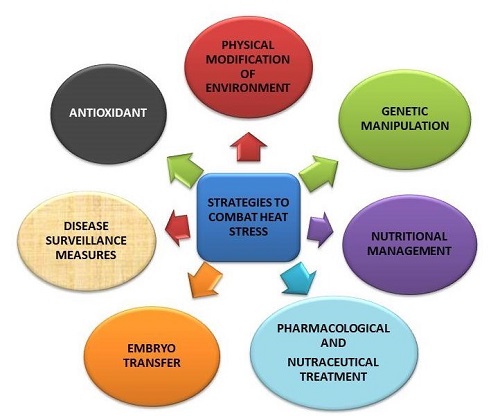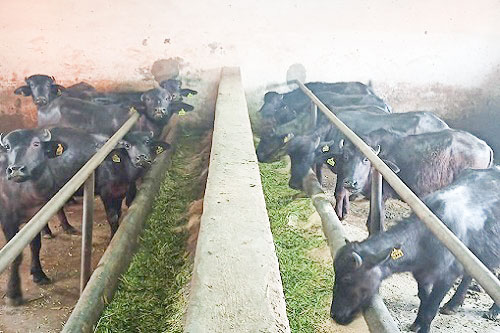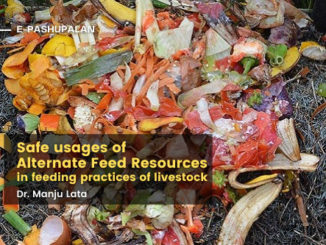Introduction
Climate change is one of the potential risk factors causing impaired performance of the livestock in India. India lies in the tropical climatic region of the earth. The average temperature is above 180C (64.40F) with hot and humid conditions. The comfort zone for indigenous cattle ranges between 18-250C (Singh and Upadhyay, 2009). However, due to the global warming the mean environmental temperature is on the rise (Harris and Roach, 2016). Any rise above 350C hampers livestock productivity. Constant exposure to such high ambient temperature gives rise to heat stress. The months of April, May and June prove to be of moderate to high heat stress in Indian cattle breeds (Soren et al., 2018). In developing countries due to the lack of better management facilities, animals are more prone to the climate change. Hence, resulting in huge economic losses for the farmers.
In order to overcome economic losses obtained due to heat stress, major strategies must be implemented. These strategies must include all the aspects like nutritional, housing, animal health and reproduction. Developing appropriate cost-effective technologies for climate change mitigation, and sustaining the livestock productivity are very important. In this article, we have described some of the major amelioration strategies to combat heat stress in Indian conditions.
Major impacts of climate change in livestock
a) Visible effects of heat stress
- Increased body temperature
- Reduced fee intake
- Increased heart rate
- Reduced milk yield
- Increased respiration rate
- Rise in rectal and skin temperature
- Decreased rumination behavior (Das et al., 2016; Soren et al., 2018)
b) Invisible signs of heat stress
- Lowers immunity
- Increased risk of mastitis and other metabolic diseases
- Reduced conception rate
- Decreased rumen functioning
- Impacts production traits
- Hampers growth of calves (Kumar et al., 2011; Chauhan et al., 2015)
Amelioration strategies to combat Heat stress
- Physical modification of the environment
- Genetic manipulation
- Nutritional management
- Antioxidants (Vitamins and minerals)
- Pharmacological and nutraceutical treatment
- Embryo Transfer
- Disease Surveillance Measures

1. Physical modification of the environment
Shade
- Provides protection to animals from harmful UV rays of sun
- Provides cooling effect of wind
- Improves reproductive performance and milk yield (Das et al., 2016)
Sprinkler-Fan system, mist and foggers:
- Decreases the ambient temperature in the areas with low humidity
- Increases milk yield
- Improves feed intake of dairy cows up to 10% (Atrian and Shahryar, 2012)
- Intermittent wetting of animals
- Apply white paint to the shed to reflect sunlight
- Sufficient floor-space requirements for animals
- Forced ventilation: Ideal wind speed in hot and humid conditions- 2.25 m/s
- Growing trees around
- Green grass in the paddocks
- Growing vegetable creepers over the sheds
- Wetting the body of the animal by hanging wet gunny bags against the direction of wind (Atrian and Shahryar, 2012; Narawariya et al., 2017)

2. Genetic manipulation
- Allelic variants of specific genes
- Selection of heat resistant animals
- Consider traits that: Control coat colour, genes controlling heat shock resistance in cells and hair length
- Genetic modification of the embryo or altering its biochemical properties before embryo transfer
- Genetic selection for improve insulin sensitivity to reduce heat stress (Hansen, 2009)
3. Nutritional management
- Feeding of the balanced ration
- Fresh, palatable and high-quality forages: Increase the digestibility and reduces the heat production by nutrient utilization
- Buffers: Lowers the incidence of Ruminal acidosis: E.g. Magnesium oxide, Sodium bicarbonate, and sodium sesquicarbonate
- Enhance energy density of ration by additional fat or grain sources in summer
- Addition of yeast or yeast culture: Maintains pH of rumen
- Feeding of dietary rumen bypass fat: Combat negative energy balance
- Feeding in cooler hours of the day (Chase et al., 2013; Gorniak et al. 2014; Narawaria et al., 2017)

4. Anti-oxidants (Vitamins and minerals)
- Exogenous supplementation
- Majorly used anti-oxidants are Vitamins C, A and E and trace elements such as zinc, copper, manganese, selenium, chromium
- Attenuate the negative effects of environmental stress and acts as Immunomodulator
- Improves conception rate, increase milk yield
- Improves growth rate in calves
- Protects from cellular damage (Kumar et al., 2011)
- Betaine- used as an organic cellular osmo-protectant
- Amla- Protect the body against free radicals
- Electrolyte supplementation: Relief from dehydration and evaporative heat loss and respiratory alkalosis (Digicomo et al. 2015)
5. Pharmacological and Nutraceutical Treatment
- Addition of fungal cultures in the feed
- Decreases body temperatures and respiration rates in high temperature regions
- Encapsulated niacin treatment in lactating animals
- Increases sweating rates
- Lowers core body temperature by peripheral vasodilation (Bilby et al., 2008)
6. Embryo Transfer
- Introduction of various cell growth factors like caspase inhibitor and insulin like growth factor-1 (IGF-1) I the embryo by genetic manipulation
- Protects cells from a variety of stresses
- Improve rates of pregnancy with embryo transfer
- Protect heat-induced cellular damage
- Developmental competence of embryos
- Enhance the embryonic survival through the administration of antioxidant (De Rensis and Scaramuzzi, 2003; Block and Hansen, 2007)
7. Disease Surveillance Measures
- To reduce the current and projected health risks due to heat stress
- Facilitate faster intervention in the event of an unexpected disease outbreaks in the livestock caused by climate change
- Better monitoring would increase the adaptive capacity if the data are provided in a timely and sufficient manner
Future Prospective
The following are the most important considerations for successful handling of environmental stress and livestock performance in the future:
- Early alert system development.
- Reaping the benefits of the genetic potential of the indigenous breeds.
- Development of appropriate breeding programmes and dietary measures are being researched.
- Improvements in water conservation strategies.
Conclusion
Climate change is one of the potential risk factors causing impaired performance of the livestock in India. In order to overcome economic losses obtained due to heat stress, these major strategies are implemented. Ameliorating strategies can help to overcome environmental stress. In India, further emphasis can be given to consider implementing modern technologies to prevent heat stress.
References
- Atrian, P. and Shahryar, H.A. (2012). Heat stress in dairy cows. Res. Zool., 2(4): 31-37.
- Bilby, T.R., Baumgard, L.H., Rhoads, M.L. and Collier, R.J. (2008). Strategies to Improve Reproduction during Heat Stress. Mid-South Ruminant Nutrition Conference. Arlington, Texas.
- Block J, Hansen PJ (2007) Interaction between season and culture with insulin-like growth factor-1 on survival of in vitro produced embryos following transfer to lactating dairy cows. Theriogenology 67:1518–1529.
- Chase, L.E. (2013). Climate change impacts on dairy cattle. http://www.climateandfarming.org /pdfs/ FactSheets/ III.3 Cattle.pdf.
- Chauhan SS, Celi P, Leury BJ, Clarke IJ, Dunshea FR (2015) Errata. J Anim Sci 93(3):1418. https://doi.org/10.2527/jas.2014-7714.er.
- Das R, Sailo L, Verma N, Bharti P, Saikia J, Imtiwati, Kumar R (2016) Impact of heat stress on health and performance of dairy animals: A review, Veterinary World, 9(3): 260- 268.
- De Rensis, F. and Scaramuzzi, R.J., 2003. Heat stress and seasonal effects on reproduction in the dairy cow—a review. Theriogenology, 60, 1139–1151.
- DiGiacomo K, Simpson S, Leury B J and Dunshea F R. 2012. Dietary betaine improves physiological responses in sheep under chronic heat load in a dose dependent manner. Journal of Animal Science 90(Suppl 3): 269.
- Harris J M and Roach B. 2016. Environmental and natural resource economics: a contemporary approach: Advance Chapter 12 for Fourth Edition- Global Climate Change: Science and Economics Replaces Third Edition chapter 18: 1–29.
- Gorniak T, Meyer U, Südekum KH & Dänicke S. 2014. Impact of mild heat stress on dry matter intake, milk yield and milk composition in mid-lactation holstein dairy cows in a temperate climate. Archives Of Animal Nutrition. 68:358–369.
- Hansen, P.J. (2009). Effects of heat stress on mammalian reproduction. Phil Trans Royal Soc B, 364:3341-3450.
- Kumar, B.V.S., Ajeet, K. and Meena, K. (2011). Effect of heat stress in tropical livestock and different strategies for its amelioration. Journal of Stress Physiology & Biochemistry., 7(1): 45-54.
- Narwaria US, Singh M, Verma KK and Bharti PK (2017). Amelioration of thermal stress using modified roof in dairy animals under tropics: A Review. Journal of Animal Research, 7(5): 801-812.
- Singh S V and Upadhyay R C. 2009. Impact of temperature rise on physiological function, thermal balance and milk production of lactating Karan Fries and Sahiwal cows. Indian Veterinary Journal 86(2): 141–44.
- Soren, S., Singh, S. V., Borah, S., Kumar, A. and Dwivedi, D. (2018). Global warming: impact, adaptation and ameliorative measures of semen quality under tropical climatic conditions in crossbred bulls. J. Anim. Res. 8, 731-739.








1 Trackback / Pingback